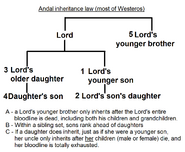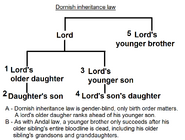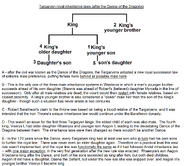Tag: sourceedit |
Tag: sourceedit |
||
| Line 66: | Line 66: | ||
Bigamy is forbidden in several major religions, such as the Faith of the Seven or the Old Gods of the Forest. The Faith of the Seven considers marrying multiple wives at the same time to be an abomination. Several other world religions, however, do practice polygamy. The ironborn under the Drowned God religion come close to this with their practice of taking one primary "rock wife" but multiple lower-ranking "salt wives (basically glorified concubines). |
Bigamy is forbidden in several major religions, such as the Faith of the Seven or the Old Gods of the Forest. The Faith of the Seven considers marrying multiple wives at the same time to be an abomination. Several other world religions, however, do practice polygamy. The ironborn under the Drowned God religion come close to this with their practice of taking one primary "rock wife" but multiple lower-ranking "salt wives (basically glorified concubines). |
||
| − | + | The medieval society of Westeros does not have a concept of an intervening life stage of "adolescence" between childhood and adulthood: the legal age of majority for boys is sixteen in the novels (though it may have been increased to eighteen in the TV series). As soon as a boy reaches his sixteenth [[Nameday|nameday]], he suddenly becomes "a man grown". The age of majority is technically the same for girls, but a girl is usually considered to become "a woman" upon [[Flowering|flowering]] (menstruating) for the first time. It is considered perverse and unusual to have sex with or marry a young girl who has not flowered yet. However, once a girl has begun menstruating, she is instantly considered "a woman" and capable of marrying (though due to lower nutritional standards in medieval societies like Westeros, girls tend to menstruate at later ages than in modern times, around 12 to 16 years old). While girls ''can'' be married as soon as they flower, however, powerful noble families will more often wait to marry off their daughters until they can find a very good marriage-pact to enter them into. While it is seen as perverse to marry and bed a young girl who has not yet flowered, betrothals can be made earlier - with the actual marriage not being entered into for several years. Such early betrothals were conducted between Sansa Stark and Joffrey Baratheon, and between [[Myrcella Baratheon]] and [[Trystane Martell]]. |
|
None of the known cultures in the novels has ever been described as practicing some form of same-sex marriage - though little has been said about cultures outside of [[Westeros]], and hardly any specific detail is known about the cultures east of the Bone Mountains (east of the Dothraki and Qarth) or the southern regions of Sothoryos. Marriages are rarely made for love in Westeros, however, but to secure political alliances - and it is generally understood that a man's closest friends will be other men, not his wife. Thus while "homosexual marriage" doesn't exist in Westeros, "homo''social'' relationships" are by far the norm. For example, the person that [[Robert Baratheon]] "loved" most in the world was his lifelong friend and brother-in-arms [[Eddard Stark]], while Robert's arranged marriage to his wife Queen Cersei was filled with mutual hatred and resentment. Somewhat similarly, Robert's youngest brother [[Renly Baratheon]] entered into a marriage with [[Margaery Tyrell]] purely to secure a political alliance with her family, not for love - when in fact he was privately homosexual, and had been in a long term sexual/romantic relationship with Margaery's own brother [[Loras Tyrell]] (which Margaery was actually fully aware of and didn't mind). Publicly, while the ''exact'' nature of Renly and Loras's relationship is a secret, the fact that Renly openly seems to have a closer relationship with Loras than with his own wife Margaery isn't seen as particularly unusual. |
None of the known cultures in the novels has ever been described as practicing some form of same-sex marriage - though little has been said about cultures outside of [[Westeros]], and hardly any specific detail is known about the cultures east of the Bone Mountains (east of the Dothraki and Qarth) or the southern regions of Sothoryos. Marriages are rarely made for love in Westeros, however, but to secure political alliances - and it is generally understood that a man's closest friends will be other men, not his wife. Thus while "homosexual marriage" doesn't exist in Westeros, "homo''social'' relationships" are by far the norm. For example, the person that [[Robert Baratheon]] "loved" most in the world was his lifelong friend and brother-in-arms [[Eddard Stark]], while Robert's arranged marriage to his wife Queen Cersei was filled with mutual hatred and resentment. Somewhat similarly, Robert's youngest brother [[Renly Baratheon]] entered into a marriage with [[Margaery Tyrell]] purely to secure a political alliance with her family, not for love - when in fact he was privately homosexual, and had been in a long term sexual/romantic relationship with Margaery's own brother [[Loras Tyrell]] (which Margaery was actually fully aware of and didn't mind). Publicly, while the ''exact'' nature of Renly and Loras's relationship is a secret, the fact that Renly openly seems to have a closer relationship with Loras than with his own wife Margaery isn't seen as particularly unusual. |
||
Revision as of 16:46, 3 October 2015
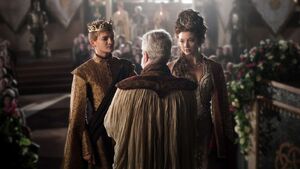
The High Septon conducting the marriage between King Joffrey Baratheon and Margaery Tyrell.
- "Your Grace, Your Grace, my lords, my ladies, you stand here in the sight of gods and men to witness the union of man and wife. One flesh, one heart, one soul... now and forever!"
- ―The High Septon
Marriage is a socially, and typically religiously, recognized union between people that establishes rights and obligations between them and their children.
Historically, some marriages signaled the adoption of an independent kingdom under the authority of another one. Such was the case of the marriage of a King in the North with the daughter of the last Marsh King, which brought the Neck into the Kingdom of the North, or the marriages of Daeron II Targaryen with Myriah Martell and Maron Martell with Daenerys Targaryen, which brought Dorne under the authority of the Iron Throne.
Marriage practices and customs
Work in Progress
Political marriage-alliances
The TV series released a behind-the-scenes video featurette about marriage in Westeros (click this link to view), in which George R.R. Martin stressed that as in the real-life Middle Ages, it is by far the norm for the nobility in Westeros to enter into arranged marriages, not for love but to secure political alliances, saying: "Marriage was a way to bind two families together, it was a form of political alliance, and royal marriages are one of the ultimate examples of this."[1]
In case of members of noble families, marriages are almost always arranged by the heads of the Houses and often seal political alliances. Marriage make both noble families kin, thus obligating them to provide military aid to each other in case of conflicts with other noble families.
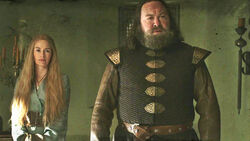
The marriage between King Robert and Queen Cersei wasn't made for love, but to secure a political alliance, which is typical among the nobility in Westeros.
Most members of the Great Houses of Westeros during the timeframe of the narrative entered into arranged marriages: Catelyn Tully and Eddard Stark, Lysa Tully and Jon Arryn, Robert Baratheon and Cersei Lannister, Stannis Baratheon and Selyse Florent, and during the narrative Margaery Tyrell and her successive husbands (Renly Baratheon, Joffrey Baratheon, and Tommen Baratheon). Sometimes with great work and effort over many years, arranged marriages turn into strong relationships - Catelyn herself championed this aspect of her marriage to Ned when trying to urge her son Robb to enter into an arranged marriage. While they may not grow to love each other, couples in arranged marriages are often able to maintain at least a functional public partnership. Many dread being trapped in miserable arranged marriages, such as Robert and Cersei, or Lysa's loveless marriage to Jon, a good man but old enough to be her father.
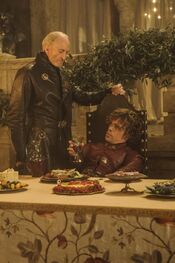
Tywin Lannister married for love, to his first cousin Joanna, but hypocritically tried to force his own children into arranged marriages.
Only two major political leaders in Westeros in the current generation married for love: Tywin Lannister and Doran Martell. Tywin married his own first cousin Joanna Lannister out of love, even though she brought him no new lands or allies. He actually loved Joanna dearly and it was said she brought out the best in him, and her death giving birth to Tyrion left him heartbroken and embittered. Later in life, Tywin hypocritically tried to force all three of his children into loveless arranged marriages (succeeding with Cersei and Tyrion). Doran Martell is an example of lord who married for love, but as happens in real life, he and his wife eventually fell out of love. In the novels, he wed the noblewoman Mellario of Norvos, but after several years she found the customs of Dorne to be so foreign that she became estranged from Doran and moved back to Norvos (divorce does not exist in Westeros), leaving Doran with a heavy heart.
Brynden Tully, Catelyn's uncle, infamously refused to enter into an arranged marriage his brother set up for him with Bethany Redwyne - despite the fact that all agreed it was a great match, as she was beautiful, wealthy, and it would gain strong allies for the Tullys. Brynden quarreled often with his brother about this over the years and became known as "the Blackfish" as a result (exactly why Brynden never married is unclear in the novels - fan speculation ranges from that he is secretly a homosexual to that he secretly loved his brother's future wife, but once they wed each other Brynden swore he would never love again). It is not unusual for lords who are privately homosexual to still marry women, such as Renly Baratheon, purely to secure a political alliance and produce heirs ("love" is not generally a major reason for marriage among the nobility in Westeros).
Annulment
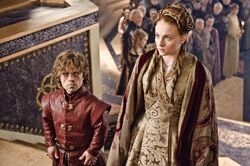
Divorce doesn't exist in the Faith of the Seven, but Sansa's marriage to Tyrion can easily be annulled upon request - it was obviously forced against her will, and Tyrion never consummated it.
"Divorce" does not exist in Westeros, though annulment does. An annulment can be requested from the hierarchy of the Faith of the Seven due to several factors, such as if the marriage was never consummated (the couple never had sex), if it is later discovered that one of the two was already married (bigamous marriage is forbidden), or if it is argued that the marriage was made under duress, because officially no one can be forced to take a holy vow against their will.
In practice, the daughters of noble Houses are often pressured by their families to marry against their will, but forcibly marrying a woman held hostage against her family's wishes is generally seen as grounds for annulment. For example, Sansa Stark was obviously a prisoner of the Lannisters when she was forced to marry Tyrion, against both her will and that of her entire family, and the marriage was never consummated, so it will be easy for Sansa to request an annulment from the Faith in the future (though she has not yet). Sansa later married Ramsay Bolton in the TV series as part of Littlefinger's schemes - but while Sansa's marriage to Tyrion could easily be annulled upon request, the request had no actually been made yet. Therefore her marriage to Ramsay in the TV series is technically bigamous, and thus also subject to annulment if it is later requested.
Wedding ceremonies and customs
The wedding ceremonies that mark the beginning of a marriage vary between different religions and cultures.
Faith of the Seven
In the case of the Faith of the Seven the ceremony is conducted by a septon. The bridegroom puts a cloak in his family colors over the bride, symbolically bringing her under his protection and into his house. The septon may then welcomes the attendees to witness the union of man and as "one flesh, one heart, one soul" for the rest of their lives. Sometimes while he speaks the words binding man and wife for eternity he will wrap a strip of cloth to join the hands of bride and bridegroom, symbolizing their union. They are then instructed to look upon each other and say the following words at unison:
"Father, Smith, Warrior,
Mother, Maiden, Crone, Stranger.
I am hers/his and she/he is mine,
from this day until the end of my days".
Afterward the newlyweds may kiss one another.
Following the ceremony, a feast is held for all attendees. After some time, the traditional bedding ceremony may take place and the newlyweds are carried to the marriage bed to spend the night together. The feast continues for the guests.
Sometimes a couple who wish to marry for love but are forced by marriage pacts to marry another or wish to marry against their family's wishes may perform secret weddings. These are still lawful, and only require, in case of the Faith of the Seven, a septon to perform the ceremony and the couple to speak their vows.
The Old Gods of the Forest
In the North, where the Old Gods of the Forest still hold sway, there is no clergy so the wedding ceremony is officiated by the groom and bride's fathers or kin (usually brothers but it can also be a ward of their family).
A ritual is conducted at night during which the bride is led to the weirwood tree in the heart of the Godswood which is lit by candles, where the groom's father demands who comes before the Old Gods. The bride's father presents his daughter who comes to beg the blessing of the Gods for her marriage before asking who comes to claim her:
- Roose Bolton: "Who comes before the Old Gods this night?"
- Theon Greyjoy: "Sansa, of the House Stark, comes here to be wed. A woman grown, trueborn and noble. She comes to beg the blessing of the Gods. Who comes to claim her?"
- — Roose Bolton and Theon Greyjoy officiating Sansa Stark's wedding to Ramsay Bolton[src]
The groom steps forward and stakes his claim before asking who gives his bride away. Once the bride's father has introduced himself, the groom's father asks whether the bride will take his son as a husband. Once the bride agrees, the wedding is done:
- Ramsay Bolton: "Ramsay, of House Bolton, heir to the Dreadfort and Winterfell. Who gives her?"
- Theon Greyjoy: "Theon, of the House Greyjoy, who was... who was her father's ward."
- Roose Bolton: "Lady Sansa, do you take this man?"
- — Ramsay claims Sansa and Lord Bolton asks her consent.[src]
Sansa Stark was wed to Ramsay Bolton in such a ceremony. Since her father and brothers were all thought to be dead, Theon Greyjoy, who had been Lord Stark's ward, gave her away while Lord Roose Bolton, Ramsay's father, officiated the ceremony.[2]
The Dothraki
The traditional Dothraki wedding ceremony is a daylong feast in which gifts are presented to the new couple. Displays of personal combat, duels to the death, and wild public orgies are commonplace at such a feast. A Dothraki wedding without at least three deaths is considered a dull affair.
Because the Dothraki spend most of their time riding on the open plains, everything of importance in Dothraki culture is done outdoors under the sky. Thus, on their wedding night, a Dothraki couple rides away from the main camp to the open plains, and consummate their marriage under the stars.[3]
Marriage prohibitions
Certain organizations make their members take vows of celibacy. These include:
- The clergy of the Faith of the Seven (both male and female members)
- The Order of Maesters
- The Night's Watch
- The Kingsguard
Bigamy is forbidden in several major religions, such as the Faith of the Seven or the Old Gods of the Forest. The Faith of the Seven considers marrying multiple wives at the same time to be an abomination. Several other world religions, however, do practice polygamy. The ironborn under the Drowned God religion come close to this with their practice of taking one primary "rock wife" but multiple lower-ranking "salt wives (basically glorified concubines).
The medieval society of Westeros does not have a concept of an intervening life stage of "adolescence" between childhood and adulthood: the legal age of majority for boys is sixteen in the novels (though it may have been increased to eighteen in the TV series). As soon as a boy reaches his sixteenth nameday, he suddenly becomes "a man grown". The age of majority is technically the same for girls, but a girl is usually considered to become "a woman" upon flowering (menstruating) for the first time. It is considered perverse and unusual to have sex with or marry a young girl who has not flowered yet. However, once a girl has begun menstruating, she is instantly considered "a woman" and capable of marrying (though due to lower nutritional standards in medieval societies like Westeros, girls tend to menstruate at later ages than in modern times, around 12 to 16 years old). While girls can be married as soon as they flower, however, powerful noble families will more often wait to marry off their daughters until they can find a very good marriage-pact to enter them into. While it is seen as perverse to marry and bed a young girl who has not yet flowered, betrothals can be made earlier - with the actual marriage not being entered into for several years. Such early betrothals were conducted between Sansa Stark and Joffrey Baratheon, and between Myrcella Baratheon and Trystane Martell.
None of the known cultures in the novels has ever been described as practicing some form of same-sex marriage - though little has been said about cultures outside of Westeros, and hardly any specific detail is known about the cultures east of the Bone Mountains (east of the Dothraki and Qarth) or the southern regions of Sothoryos. Marriages are rarely made for love in Westeros, however, but to secure political alliances - and it is generally understood that a man's closest friends will be other men, not his wife. Thus while "homosexual marriage" doesn't exist in Westeros, "homosocial relationships" are by far the norm. For example, the person that Robert Baratheon "loved" most in the world was his lifelong friend and brother-in-arms Eddard Stark, while Robert's arranged marriage to his wife Queen Cersei was filled with mutual hatred and resentment. Somewhat similarly, Robert's youngest brother Renly Baratheon entered into a marriage with Margaery Tyrell purely to secure a political alliance with her family, not for love - when in fact he was privately homosexual, and had been in a long term sexual/romantic relationship with Margaery's own brother Loras Tyrell (which Margaery was actually fully aware of and didn't mind). Publicly, while the exact nature of Renly and Loras's relationship is a secret, the fact that Renly openly seems to have a closer relationship with Loras than with his own wife Margaery isn't seen as particularly unusual.
Most cultures across Westeros and Essos have rules against Incest - sexual contact between direct family members (siblings, parents, or children), though the specific rules can vary. Most major religions in both Westeros and Essos consider marriage between brothers and sisters to be incest.
The dragonlords of the old Valyrian Freehold, however, who once ruled much of Essos, preferred to marry brother to sister "to keep the bloodlines pure". The Doom of Valyria, four hundred years before the War of the Five Kings, wiped out their civilization. One Valyrian noble family, however, survived the Doom with living dragons: House Targaryen, which a hundred years later conquered and unified the Seven Kingdoms, and proceeded to rule them for the next three centuries.
The Targaryens' continued practice of incestuous brother-sister marriages was always a point of contention with the Faith of the Seven, which considered it to be an abomination. This led to outright war between the Faith and the Crown in the generation after the conquest, when Maegor Targaryen brutally fought rebellions by the Faith Militant, quickly earning him the nickname "Maegor the Cruel". Maegor's brutal tactics eventually led to a successful rebellion in favor of his nephew Jaehaerys I Targaryen. While Jaehaerys was married to his own sister, he was a wise diplomat and sought peace with the Faith, successfully negotiating that it didn't have to accept the Targaryens' incestuous marriages, but only acknowledge them - the rationale being that the Targaryens' royal status set them above the rules of normal men. This arrangement successfully held for the next two and a half centuries that the Targaryens held power (though they didn't always marry their sisters in every generation).
There is no indication that any culture in Westeros or Essos ever condoned sexual relations, much less marriage, between parents and their children - not even the Valyrians. Craster, a wildling living on a very isolated homestead in the wilderness beyond the Wall, would "marry" his own daughters, to father more daughters on them that he would in turn marry (such as Gilly) - but this was only possible due to the extreme isolation they were living in, not condoned as part of a "society". Even the other wildlings utterly despised Craster, and what he was doing was not remotely considered acceptable in wider wildling society.
Marriage between first cousins is not uncommon among the nobility of Westeros, and is not considered incest in their culture. Even Tywin Lannister married his own first cousin, Joanna Lannister. The Valyrians (and later, the Targaryens) preferred to marry cousins of as close a degree as possible if there were no sisters in the current generation of their families. They were also known to have marriages between uncles and nieces (and probably also aunts and nephews): Rhaenyra Targaryen herself married her own uncle, Daemon Targaryen (though uncle-niece marriage is not as close a degree of incest as brother-sister incest).
Bastardy
- See main article on "Bastardy"
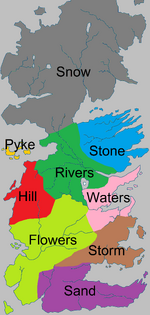
Bastard names by region.
Bastardy - when children are born outside of marriage - is considered so shameful in Westeros that the acknowledged bastard children of the nobility have to use special bastard surnames, one surname for each of the Seven Kingdoms. Bastards from the North use the surname "Snow", such as Jon Snow and Ramsay Snow. Bastards from the desert kingdom Dorne use the surname "Sand", such as Ellaria Sand, as well as Oberyn Martell's daughters (nicknamed "the Sand Snakes" as a result). Dorne has different views on sexuality than the rest of Westeros, and unlike the other kingdoms the Dornish don't consider bastardy to be particularly shameful. Only bastards of the nobility can use these surnames. Bastards are excluded from the line of succession, though on rare occasion a king might grant them Legitimization. The TV series released a behind-the-scenes video featurette on "Bastards of Westeros" including comments by Martin himself (click this link to view).
Inheritance law
- See main article "Lordship"
There are three major systems of inheritance law practiced in the Seven Kingdoms, all variations on the winner-take-all rule of primogeniture. Most of the Seven Kingdoms follow male-preference primogeniture: sons rank ahead of daughters in the line of succession (i.e. Bran Stark is ahead of his older sister Sansa Stark in the line of succession, and Tyrion was ahead of his older sister Cersei).
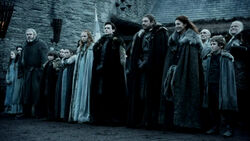
The House Stark line of succession at the beginning of the narrative is: 1 - Robb,
2 - Bran, 3 - Rickon, 4 - Sansa, 5 - Arya. Rickon outranks his older sister Sansa. Jon Snow is a bastard, with no right to inheritance.
Dorne is an exception: due to resisting conquest by the Targaryens and only joining the realm one century ago through marriage-alliance the Dornish were allowed to keep many of their local laws, including gender-blind primogeniture. As a result, in the novels Prince Doran's heir apparent is his daughter Arianne, not her younger brothers (Arianne seems to have been cut from the TV series). In both of these systems, a lord's younger brother only inherits after even the lord's last daughter is dead.
Royal inheritance law was heavily modified after the Dance of the Dragons to place female heirs to the throne behind all possible male ones (in the hope that this would prevent another civil war). Season 1 of the TV series outright states that if Sansa only has daughters with Joffrey, the Iron Throne would pass to Joffrey's younger brother Tommen, and also that even Robert's second brother Renly is ahead of Myrcella in the line of succession. This is true under royal inheritance law but not for the normal inheritance law, which is followed by Winterfell. Indeed, by Season 5 when all of the legitimate Stark sons are believed dead, Sansa is repeatedly referred to as the legitimate heir to Winterfell. Because the Targaryen exiles considered the Baratheons to be pretenders to the throne, Daenerys was officially the heir of her brother Viserys for many years, simply because all other male Targaryens had in fact died by that point - making Daenerys, upon Viserys's death, the first Targaryen woman to lawfully claim the throne under the modified royal inheritance laws.
Charts of the three inheritance systems:
Prominent marriages
Wed during the TV series in on-screen ceremonies
- Khal Drogo and Daenerys Targaryen, arranged by Illyrio Mopatis to secure an army for Viserys Targaryen's return to the Seven Kingdoms. Ended with Drogo's incapacitation and mercy killing by Daenerys herself.
- Robb Stark and Talisa Maegyr, secretly married for love, breaking the marriage pact between House Stark and House Frey and ultimately leading to the Red Wedding.
- Tyrion Lannister and Sansa Stark, arranged and forced by Tywin Lannister to provide House Lannister with power over Winterfell and the North through Sansa's claim. Unconsummated.
- Edmure Tully and Roslin Frey, arranged by Robb Stark with Lothar and Black Walder Frey on behalf of Lord Walder Frey to amend the Stark-Frey alliance. Led to the Red Wedding.
- Joffrey Baratheon and Margaery Tyrell, arranged by Petyr Baelish to cement the Lannister-Tyrell alliance. Breaks the bethrothal of Joffrey with Sansa Stark that had been arranged by the late King Robert. Unconsummated because of Joffrey's death at the wedding feast.
- Tommen Baratheon and Margaery Tyrell, arranged by Tywin Lannister and Mace Tyrell to secure the Lannister-Tyrell alliance following the death of King Joffrey.
- Ramsay Bolton and Sansa Stark, arranged by Petyr Baelish and Roose Bolton to cement the hold of House Bolton over the North, where loyalty to House Stark runs deep and ancient. This marriage is considered lawful because Sansa's previous marriage was never consummated - though it can be construed as bigamous and non-binding, given that while Sansa's previous marriage to Tyrion can easily be annulled, it hasn't been officially annulled yet.
Wed during the TV series, but off-screen
- Renly Baratheon and Margaery Tyrell, cementing House Tyrell's support for Renly's claim to the Iron Throne. Went unconsummated before Renly was assassinated.
- Roose Bolton and Fat Walda Frey; Bolton chose her when Walder Frey offered him any of his grandaughters in marriage; with the bride's weight in silver as dowry. Bolton chose the fattest girl.
- Petyr Baelish and the widowed Lysa Arryn. The marriage was meant to bring the Vale back under the authority of the Iron Throne, as House Arryn had remained neutral in the War of the Five Kings, and to make Petyr the Lord Protector of the Vale. The marriage lasts only a fortnight, as Petyr murders Lysa.
Wed before the TV series
- Tywin Lannister and Joanna Lannister, cousins who married out of love.
- Eddard Stark and Catelyn Tully, bound to marry after Catelyn's first betrothed, Brandon Stark was executed by the Mad King.
- Jon Arryn and Lysa Tully; along with Eddard and Catelyn's wedding, this marriage sealed the alliance of the houses in rebellion against the Mad King.
- Robert Baratheon and Cersei Lannister, this marriage cemented the support of House Lannister to the new King.
- Stannis Baratheon and Selyse Florent, carried out before Robert's Rebellion. Helped cement the support of House Florent to Stannis' claim to the Iron Throne following the death of Renly.
- Tyrion Lannister and Tysha, a secret wedding carried out by a drunk septon. Forcibly annulled by Lord Tywin, who revealed that Tysha was just a whore, and ordered his guards to gang-rape her, before sending her away.
In the books
Marriage is presented as a cultural universal in the A Song of Ice and Fire novels: every culture across the known world has some version of it. How each culture defines marriage, however, can vary considerably, i.e., some cultures practice polygamous marriages but others do not.
Marriage customs and wedding ceremonies in a few other cultures and religions have been described:
Not much has been said about the wedding ceremony in the religion of the Drowned God. The ironborn apparently don't have "temples" or religious structures, but conduct religious rituals on the shores of the ocean - such as Theon's baptism to reaffirm his faith seen in book/Season 2. It seems probable that weddings among the ironborn are also conducted on the shores of the sea, and possibly involve wading into the water, etc.
In the Lord of Light religion, the wedding ceremony is conducted by a Red Priest (or Red Priestess), and involves the bride and groom jumping over a bonfire that has been set in a ditch. Symbolically, two separate people begin the jump, two separate souls/flames, but as they pass through over the bonfire their two souls/flames join as one. The only example of such a wedding seen so far in the novels was performed by Melisandre at Castle Black, when one of the wildling leaders marries the Northern noblewoman Alys Karstark. Both the bride and the groom actually followed the Old Gods of the Forest and didn't convert to the Lord of Light religion - the wildlings just don't really have any wedding ceremony rituals, there is no heart tree at Castle Black to conduct a wedding in, and Melisandre happened to be there. Apparently they just enjoyed the ceremony of it - or, possibly, because they wanted to curry favor with Stannis Baratheon's faction given that Alys was opposed to Bolton rule of the North, and Queen Selyse (who was left at Castle Black in the novels) was in attendance for the wedding. Given that neither the bride or groom were actually followers of the Lord of Light religion in this instance and it was arranged rather quickly (and held during a snowstorm), it isn't clear how representative this example is of a "typical" wedding ceremony in the religion.
In Slaver's Bay weddings are conducted a the city's Temple of the Graces. There are also various customs surrounding a wedding. In Meereen (and presumably the other cities) one of these is that before the wedding, it is expected that the women of the groom's family will inspect the genitals and womb of the bride, to confirm that she is fertile. This is a hallowed and serious custom, also overseen by several of the Graces from the temple (the Blue Graces are known to serve as healers trained in medicine). Men are apparently forbidden to be present. After it is successfully completed, the bride and assembled women eat a special cake which is only made for this event, and which men are forbidden to taste. Another hallowed custom is that the bride symbolically washes the feet of the groom, symbolizing that she will be his handmaiden (it isn't clear if this happens at the actual wedding ceremony or another time). The wedding garments are also fraught with meaning: the bride is dressed in dark red veils above a tokar of white silk, fringed with baby pearls. The pearls symbolize fertility: the more pearls the bride wears, the more healthy children she will bear. These customs are described to Daenerys Targaryen when she is preparing to marry Hizdahr zo Loraq. She refuses to be inspected by the women of Hizdahr's family - in part, secretly, because she fears that the stillbirth of her son Rhaego caused by Mirri Maz Duur also left her womb infertile, and if this is discovered in the ceremony she will lose the political alliance she wanted to secure with the marriage. She also scoffs at symbolically washing Hizdahr's feet, though she agrees to wear the Ghiscari-style wedding dress.
Qarth has its own unique marriage customs, some of which are described to Daenerys when she is contemplating a political marriage-alliance with Xaro Xhoan Daxos. After they are married, a Qartheen husband and wife each retain legal ownership over their previous properties and possessions. However, a custom is that at the wedding, the groom may ask for any of the bride's possessions, and the bride in return can ask for any of the groom's possessions. This request cannot be denied, no matter what it is for, and is seen as a symbol of trust between the two of them. When Daenerys hears of this she realizes that Xaro would use it to lay claim to one of her three dragons, because he knew she wasn't aware of the custom. This sours her on the idea of marrying him and she prepares to leave Qarth. Meeting him a last time, she sarcastically counters that if she did marry him, while she couldn't prevent him from asking for one of her dragons, the equal gift she would ask for in return would be a third of all the ships - not a third of all the ships in Xaro's merchant fleet, or in all of Qarth, but a third of all the ships in the entire world. Xaro scoffs at this and they part ways.
Annulment
The concept of divorce is unknown in Westeros, but marriage can be annulled. In the episode "High Sparrow", Littlefinger claims "Tyrion never consummated the marriage. By the law of the land, she's no man's wife". In the novels it is not that simple: in "A Storm of Swords" Tywin tells Tyrion "Do I need to remind you that a marriage that has not been consummated can be set aside?", and Tyrion answers "By the High Septon or a Council of Faith". Hence, marriage can be annulled on the ground of non-consummation, but not automatically - there has to be an official ceremony conducted by clergymen. It is unclear if both husband and wife must be present, or one is sufficient. Tywin did not say if marriage can be annulled by other reasons, like forced marriage, false identity (Jeyne Poole), or absence of the bride (Asha).
In real life
Marriage is a socially recognized union between people that establishes rights and obligations between them and their children. While in a broad sense "marriage" of some kind is a cultural universal found in all human societies throughout history, the exact definitions of "marriage", like conceptions about sexuality as a whole, have varied considerably across different cultures and within the same cultures across time (i.e. some cultures practice polygamous marriages, others do not). Even in Christian Western Europe, strictly speaking, from the fourth to twenty-first centuries there has never been one "traditional" definition of marriage, the definition changed every three or four centuries.
Prior to the year 1000 marriage in Europe was largely a contractual arrangement made by two families to link them together, for political alliance and transfer of property. A son from one family married the daughter from another: ostensibly, the wife would only have procreative sex with her husband and thus marriage confirmed that all of her children were fathered by her husband - which made them "legitimate", confirmed heirs, capable of inheriting his family's property. Men, however, often kept several long-term concubines alongside their wives, who often had official status and certain legal rights. A social/emotional or spiritual union between the husband and wife was not expected, and religious overtones were minimal.
The definition of "marriage", and standards about sexuality in general, in the real-life Middle Ages were drastically changed by the Gregorian Reform movement within the Christian Church after the year 1000. The reformers enforced clerical celibacy (which had not been practiced in the first 1,000 years of Christianity) to lessen the control of political dynasties over powerful Church offices. Thus "marriage" was redefined again to be something the clergy couldn't do. This led to the Church propagating the view that the celibate life was the ideal mode of living, and sex among non-clergy was only permissible within marriage, exclusively for the necessary evil of producing children. Marriage among the non-clergy was redefined as "monogamous, indissoluble...a relationship in which sexual intercourse could give rise to children who could inherit property."[4]
At the same time, the Church reformers started attempting to infuse spiritual values into marriage, redefining it as not simply a social contract but a profound religious/spiritual union. They propagated for the first time the view that marriage was a holy vow that had to be actively consented to by both persons: to be sure, many families still forced their daughters to "consent" to political marriages, but they never would have bothered to pay this token lip-service to the idea of consent during the pre-Christian Roman era.[5]
In Game of Thrones Season 3 episode 6 "The Climb", Edmure Tully complains that he can't be forced to enter into a marriage-alliance with a Frey girl, because a man cannot be forced to take holy vows without his consent - which is a reference to this concept. In the TV version his uncle Brynden simply threatens to punch him if he refuses, but in the book version, Brynden more politely urges that while he's one of the last men who should be giving such a command (given that he refused his own brother Hoster's command to enter into an arranged marriage), Edmure must go through with it because they desperately need to repair their alliance with the Freys. Sansa Stark and Tyrion Lannister are also forced to marry each other against their wills (particularly, Sansa, a captive of the Lannisters), but they still make her go through the token gesture of saying "yes" during the marriage ceremony. Even in the late Middle Ages, marriages were rarely made for love, but to secure political alliances and rights to property:
- "Marriage in the Middle Ages was not an affirmation and official recognition of love between two people as much as it was the establishment of a legal unit which legitimized children and facilitated the transfer of property from one family to another and one generation to another."[6]
The Gregorian Reforms of the eleventh century not only resulted in a celibate priesthood, but succeeded in making a politically stronger clergy not dominated by the nobility, who could in time pressure the aristocracy to accept their moral dictates. The Catholic Church began to redefine marriage by placing limits on incestuous marriage between cousins of a certain degree (see the main article on "Incest"). Where once a man could marry his first cousin, he now could not marry his third cousin or any closer relation. It is theorized that the Church put limits on incestuous marriages within certain degrees because it often led to civil wars within families, as it left the succession order muddled.[7]
Attitudes about marriage changed somewhat after the Black Death devastated Europe starting in 1346, which killed over a third of the population. For the first time there was a massive labor shortage, with not enough peasants to work the fields and feed the towns and cities. While the Church used to espouse that marriage was distant second to choosing a life of celibacy, after the plague Church sermons began praising and valorizing marriage as also a worthy state of living, to encourage the commoners to produce more children.[8] Westeros's analogue of the Black Death was the Great Spring Sickness, a major plague that broke out about 90 years before the events of the main novels: the plague strikes right after the first of the Tales of Dunk and Egg prequel novellas, and thus the bulk of their stories take place in the plague's aftermath. The massive depopulation caused by the plague may have had a similar effect on attitudes about marriage in Westeros.
See also
References
- ↑ "Politics of Marriage" video featurette
- ↑ "Unbowed, Unbent, Unbroken"
- ↑ "Winter is Coming"
- ↑ Ruth Mazo Karras, Sexuality in Medieval Europe: Doing Unto Others (Routledge, 2005, 2d ed. 2012), 156.
- ↑ Karras 70.
- ↑ Karras 147
- ↑ Karras 68
- ↑ Karras 68

